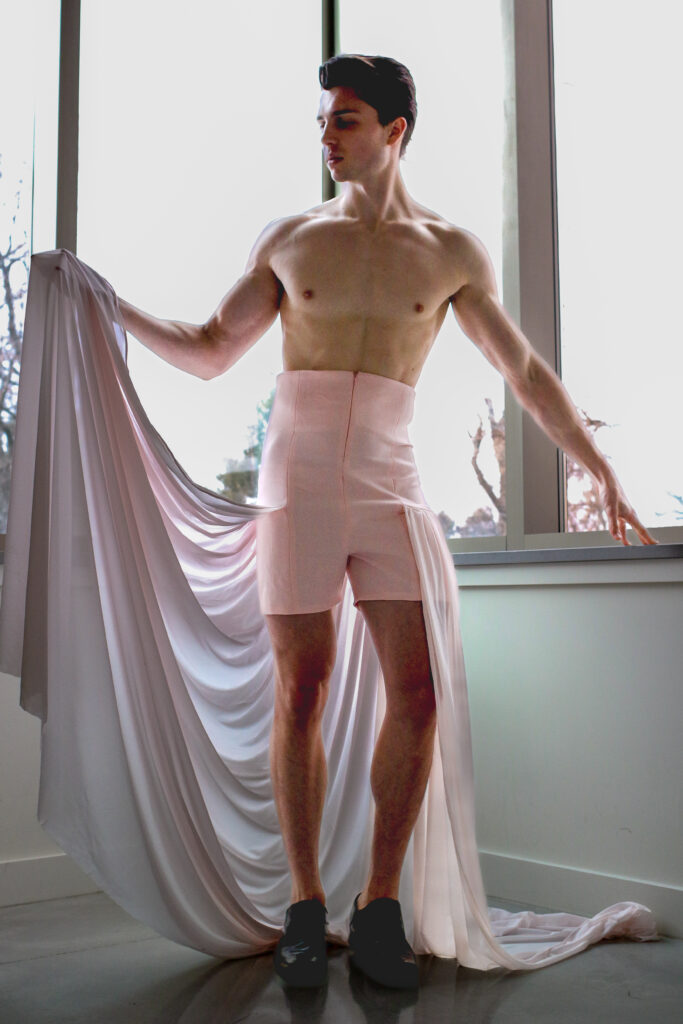When Jae Moyer walks into an H&M, they don’t head straight for the men’s or women’s section. They look around for something that catches their eye. Maybe it’s a pair of men’s ripped jeans. Or a women’s cardigan.
For 24-year-old Moyer, an engagement coordinator at a nonprofit in Merriam, Kansas, clothing doesn’t have a gender. Regardless of the section it comes from, Moyer, who is nonbinary, likes to wear what makes them feel good.
“If I see a pair of women’s pants that I’m like, ‘I feel like I would feel great in those,’ and I try them on and that’s true, then I’ll buy them,” Moyer said. “It’s not about women’s clothes or men’s clothes, whatever. I just like to go out and try to find clothes I feel like I can be and look professional in.”
At its essence, this is gender-neutral clothing, an umbrella term for clothes that are inclusive of many body types and don’t adhere to the traditional labels of “men’s” or “women’s.”
“I think the bigger question is, what makes clothing gendered? It’s all pieces of cloth stitched together with thread. There are no inherent properties that would make a piece of clothing ‘menswear’ or ‘womenswear,’” said Scott Lehmann, a Minnesota-based designer of genderless clothing. “These labels are assigned to that piece of clothing by the designer, or the department of the store it’s located in or the model that wears it.”
Like Moyer, many Gen Z and Millennial shoppers are rejecting these labels in their own personal style.
“When I see what other people are wearing on Instagram, on TikTok or other social media places, I do notice that a lot of people seem to be getting really creative with the type of stuff that they’re wearing,” Moyer said. “And a lot of people are kind of shopping across the aisles, you might say.”

Change From The Bottom-Up
Recent data backs up Moyer’s experiences. According to The Gen Z Fashion Report by UNiDAYS, a 2022 report including responses from over 4,000 Gen Z students, 65% of those surveyed said their online shopping experience would be improved if there was a “gender neutral” search option.
“Younger generations seem to be pushing against the things they feel were forced upon them,” said Alexander Lehr, another Minnesota-based non-traditional fashion designer. “Likewise, every generation that comes next has a greater sense of individualism, which directly contradicts that older mindset of not sticking out.”
Of the students surveyed for The Gen Z Fashion Report, 61% believe the mainstream fashion industry overlooks minority groups, including nonbinary and transgender people.
“I feel we’re in the midst of a cultural sea-change – one that is long overdue,” said Maria Borromeo, founder and CEO of all-gender apparel brand ClHu. “This generation is so absolutely free. It’s a freedom that’s not rebellious. They’re not out to prove a point. It’s just inherently who they are. There’s an acceptance and a fluidity to their language that is awe-inspiring, and that is reflected in their personal style and shopping habits.”
One of these young people is Borromeo’s 16-year-old daughter, who has “never subscribed to and always bravely rejected socially imposed gender norms.” It was her daughter — and young people like her — who inspired Borromeo to start her online clothing company.
“Her resolve to show up in a way that felt authentic to her was inspiring, to say the least. Yet it was always very frustrating because we could never find clothes that she felt comfortable wearing,” Borromeo said. “There was a lack of cool, well-designed, well-made, functional clothes that were not categorically binary. This was a huge problem.
“There is a new generation to serve that wants to be better and do better. But we weren’t giving them any better. So, I was inspired to create a brand that represents the best of what should be expected from a brand.”
Borromeo has worked to cater to this demographic by creating comfortable, stylish clothing that fits all body types and by making clothing “less disposable” — providing high-quality clothing that does not feed the buy-and-dispose cycle of fast fashion.
“They are conscious consumers who spend their money with purpose and understand that the decisions they make impact the world around them,” Borromeo said. “I think other generations can learn a lot by watching this generation, how they accept and express themselves, how they respect other humans’ individual and unique nature and how they make conscious decisions to protect the world we live in.”

Virtual Safe Space
Though the concept of gender-neutral clothing has been in the public eye since the 1960s, gender-neutral options have only recently started to evolve. Borromeo realized the lack of options was an issue while helping her daughter look for clothes that fit.
“We see sweats…lots of sweats,” Borromeo said. “There is a lack of everyday lifestyle pieces that you can build a wardrobe around that fit on multiple body types.”
Moyer has also encountered problems finding gender-neutral clothing that’s inclusive of all sizes and body types, especially when shopping in the Midwest.
“From what I’m seeing in mainstream stores and clothing lines, a lot of it doesn’t even fit me, and I’m not even that big,” Moyer said. “So yeah, I do think that there needs to be a push to be more inclusive for all body sizes and body types, but I’m not sure that will happen anytime soon, either.”
Lehmann, who sells everything from flowy dresses to custom-made geometric jackets online, said it’s difficult getting shelf space for gender-neutral clothing in traditional stores.
“I think the biggest challenge of making gender-neutral clothing is having a space to sell,” Lehmann said. “Unisex clothing may be on the rise, but gender-neutral retail spaces are still pretty rare, and not just in the Midwest.”
For in-person shopping, Moyer prefers stores like Torrid that are size-inclusive and don’t place an emphasis on gender. Because genderless clothing has yet to enter most retail stores, Moyer relies on online shopping for more gender-neutral options.
“Stores don’t seem to be moving away from the men’s section, women’s section type of thing. It’s all very gendered,” Moyer said. “I would hope that my generation, who is kind of moving away from gendered clothing, would have some type of impact on that changing, but I’m not 100% certain that will be a reality anytime soon.”
In fact, according to Lehmann, most gender-neutral clothing sales are online. That makes it hard to pinpoint target market for tradition retail.
“The big obstacle…is the idea of a target market. It is the first thing you are supposed to do when coming up with a business plan or designing a collection: what gender, what race, what income bracket, what body type is the person you are going to target with your product,” Lehmann said. “I think that is what is going to hold back the idea of gender-neutral clothing and stores more than anyone’s objection to whether a cis man can pull off a floral skirt.”
The Revolution
Gender-neutral fashion, now on the rise among young people as a whole, originally found its roots in the LGBTQ+ community.
“The LGBT community have and always will be pioneers. And I cherish that,” Lehr said. “With the rise of social media and a loosening of those gender norms from earlier, I think more and more, we get all walks of life trying things they’ve never tried before. Something as simple as guys painting their nails was not a thing straight men did a decade ago unless they fit into specific subsects of society — like punk, rock. Nowadays, black nail polish is everywhere.”
Both Lehr and Lehmann have noticed their clientele become more diverse as gender-neutral fashion gains traction with young people.
“I have a really diverse mix of clients,” Lehmann said. “I don’t think a lot of them find me because they are searching for gender-neutral clothing, but instead are drawn to my aesthetic but appreciate that I have not assigned a gender.”
Borromeo agreed, saying ClHu customers are generally drawn to the clothing for its design rather than “because they are gender neutral, or all-gender, as we say.”
“If you like the way something fits, you like the product and you subscribe to the company’s values, then it’s for you,” Borromeo said.
While Lehr and Lehmann don’t see gender-neutral fashion being popularized in mainstream retail stores anytime soon, they agree it’s become a more widely-accepted option as younger generations push back on gender roles and social norms.
“I don’t think gender-neutral will ever be considered fully mainstream,” Lehr said. “But I don’t think that means clothes have to be inherently gendered. It’s all about the rationale one uses to live their life.”

